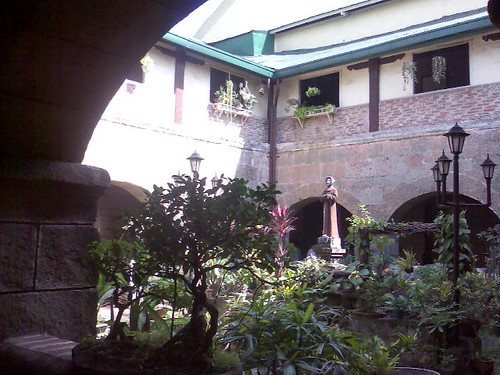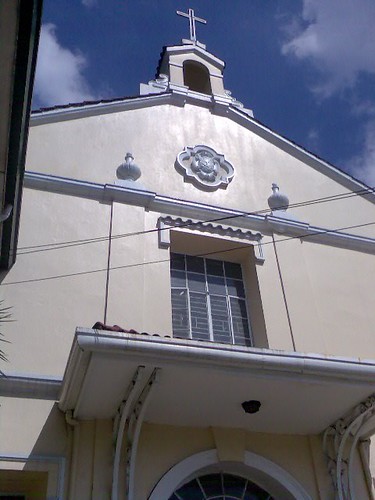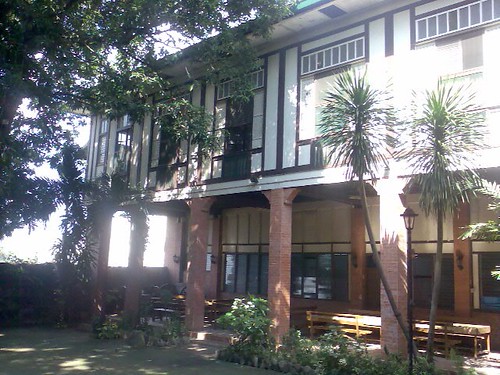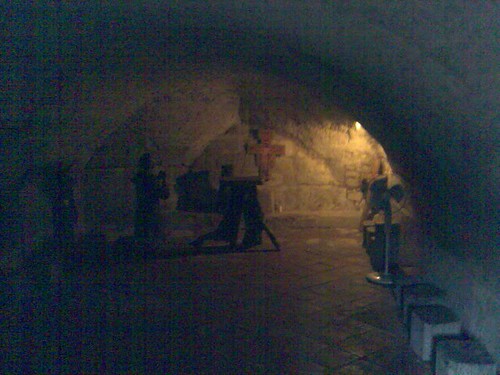
- The Franciscan Garden
Just when you thought that Quezon City has nothing to offer but the metro feel, top schools, colossal malls and trendy subdivisions, think again.
When you reflect on the old Filipinas what comes to mind is Manila and the well-known provincia's (Vigan, Taal etc) but rarely someone would think of Quezon City as having something similar to the grand old churches and casa's of this enchanted Filipino Spanish towns.

- The new fascade of the ol' Iglesia (it still stands on the original foundations of the first church, the rearrangement and renovations has drastically altered the first church)
Well, of course there are fine historical sites in Quezon City, I've always wanted to visit President Quezon's final resting place in Quezon circle but never had the time (or find not to have time). In Bagong Silang you have the site of the "Battle of San Mateo", Pugad Lawin and the Tandang Sora Shrine, just to name a few.
But the most amazing discovery I made recently was the Franciscan church in San Francisco del Monte, and it was a wonderful discovery. For hundreds of years it has served its dominion, not only establishing Christianity, which it has successfully completed but also introduce arts, like music. The town organizer and church builder, San Juan was a gifted musician.
Driving from Manila via España to Quezon City most of the times is a taxing charge(especially if your from the south metro), passing through this major roads are always better during the weekends. I thought for awhile that Sr.Gomez would take us to Santo Domingo, the church that was originally built in Manila but was later relocated because of its demolition during the American's unrelenting offensive of Manila (Liberation?). The La Naval de Manila (in Quezon City?) culture lost its continuity - but there must be some divine explanation we don't know that would explain why, the old site I believe is where BPI now stand in Intramuros.
Going back to this goldmine of a discovery, we headed to the San Francisco del Monte Church and was welcomed by its historical markers, appraising it made me appreciate that I was in one of the oldest church in this once Spanish province, here, in the heart of the metropolis.

- The Antillan
Pedro Bautista Blasquez arrived in 1584 with the 4th group of Franciscan Missionaries to the Philippines, was not an inexperienced man. He was 42 years old who acquired fame as a preacher in the cathedral of Toledo, Spain. He taught philosophy for three years in Madrid and was an excellent musician. He arrived as the head of the mission and was to preside as the chapter of custody. In a word he was a mature man, educated, experienced and placed in a position of authority.
The fourth Chapter of Custody and the first after the arrival of Pedro Baustista was held in the convent of Manila on September 24, 1584. The conference elected Pedro Bautista, Custos of Superiors of all Franciscans in the Philippines.
Apparently he preferred not to accept the position of authority. After the election Fray Pedro hid and only later when his brethren refused to accept his resignation did he took the position. That was in 1588. having accepted the responsibility he put himself dynamically into his work. He animated his religious to live out their profession and to care the conversion of others. To encourage them he learnt the language of the natives. He counseled his Friars living at a distance and encouraged them with his letters worthy of a holy man.
Because of his deep concern for the spiritual welfare of his friars, Pedro Bautista saw the need for a secluded place where the missionaries, true to reform spirit of their province, could revive their spiritual vigor by prayer, reflection and discipline. After a long search, he selected a site a little over a league from Manila.
On February 15, 1590 Gov. Santiago De Vera donated "Una Pequeña Encomienda", an estate of some 150 hectares to the Franciscans: Pedro Bautista immediately ordered the construction of a small bamboo and nipa convent and church under the title of Nuestra Señora de Montecelli, which however, was popularly known from the very beginnings of "San Francisco Del Monte".
It was opened as a retreat for missionaries and as a novitiate house from 1580 the novitiate had been in San Francisco De Manila but the noise of the city and the coming and going of the friars to the Provincia headquarters made it less than appropriate for contemplation. The first profession recorded in San Francisco Del Monte took place in December of 1591.
- The cave for prayers (yes, this guys are pretty serious with their prayers that they dug a cave where they can pray in complete silence)
In 1699, a church was made of stone was built and the convent restructured. This was dedicated t the newly beatified Blessed Pedro Bautista and his companion martyrs. This church had now become the sanctuary with the Baroque altar that is still preserved today.
In 1895, the friars abandoned the lace and Filipino revolutionary forces occupied the church. In 1898, American Negro soldiers of the occupued the church. the church was left idle until it was repaired in 1912. In 1914, the Church was blessed and a town fiesta was held in honor of San Pedro Bautista.
On November 11, 1932, the Church was declared a parish name in honor of its founder and patron saint, San Pedro Bautista, before the decree, the parish belonged to the parish of Caloocan.
In 1989, the three century old baroque altar was transferred to the main sanctuary. In 1990, a statue of San Pedro Bautista was enshrined at the center of the altar. One February 5, 1997, the parish marked the 400th anniversary f the Martyrdom of San Pedro Bautista. On February 25, 2007 the parish church was declared an archdiocesan shrine to be known as Sanctuario de San Pedro Bautista in view of its monasterical and religious significance.
After a successful effort from Padre Gobo left for Manila but he was lost at sea. Gov. Dasmariñnas waited one futile year for his return then decided to send Pedro bautista as his new ambassador. brother Gonzalo Garcia who knew Japanese very well was designated as the new emissary's interpreter; tow other completed the group. after his diplomatic mission Pedro Bautista was to stay on as the permanent representative of the Governor of Manila and labor for the conversion of the Japanese.
That was the plan of the Governor but the "Superior of the Jesuits in Manila" reminded him of the prohibition of Gregory XIII. The Governor called a meeting at the church of San Agustin on May 18, 1593 to discuss with the prominent theologian and authorities what could be done. The outcome was his firm decision to send Bautista's party.
On May 30, 1593 Pedro Bautista and his companions sailed for Japan, their new work and eventually their martyrdom four years later.
Continuing the policy of his famous predecessor Fray Juan de Placentia, "The Father of Reductions", San Pedro worked to gather the native of the towns. In Morong, he obliged the numerous rancherias spread throughout the mountains to form the "Doctrinea" of Morong. He was the moving spirit behind the behind the foundation of many towns. In Camarines: Quipayo, Cagsawa, Baac, Oas, Libmanan and Buhi. In Laguna - Rizal area: Tanay, Baras, Longos and Paquil. And in Bulacan: Catangala (Polo). He likewise started churches and convents of Meycuayan and Calilay, centers in the days of Bulacan and Tayabas.
It was a great experience walking around, seeing people celebrate mass on a Sunday, thinking that Catholic tradition here is almost as old as the founding of the walled city, it was alive, surviving the wars (both sectarian and military conflicts). The place is a legacy of the Catholic missionaries. It reminded me how it all happened, the religion and the country.
One of the most interesting historical facts that were not taught in schools is that this Catholic missions, founded almost all of our old towns, paving the way to unanimity, inspiring the shape of the islands into what we know now as the Philippine Islands, christianization and domination, and perhaps its unseen and under valued gift, our identity.
As I was walking along the Franciscan garden I tried to visualize what it was like living their lives, far away from their beautiful mother country, the endless prayers and the remote, often, perilous missions to convert, some say we never desired their interference and Christian convertion but we still remain transformed Katoliko's anyway, to say now that 'all Friars' - are wicked and that they corrupted us, is plainly erroneous.
Let's give credit, where credit is due
...speaking of credits, this two brought me here.
...speaking of credits, this two brought me here.
Gracias, mis amigos...

- Pepito, me & the man, the legend GGR




No comments:
Post a Comment